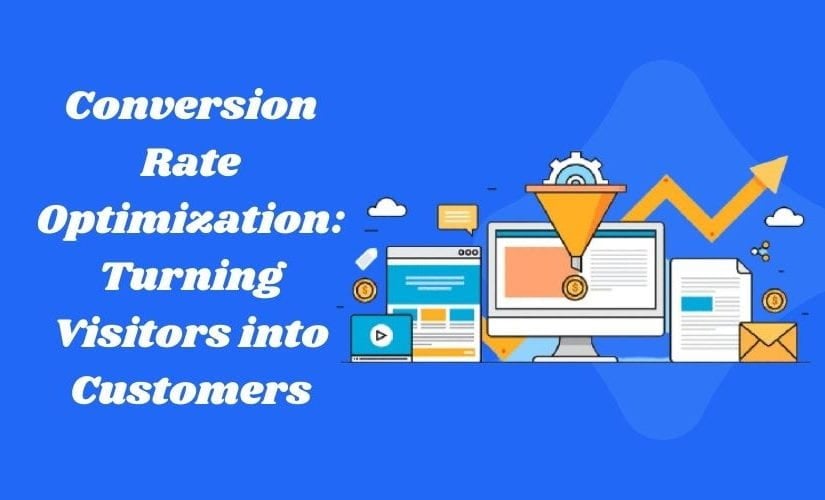Introduction to Conversion Rate Optimization: Conversion Rate Optimization (CRO) is the systematic process of increasing the percentage of website visitors who take a desired action, such as making a purchase, signing up for a newsletter, or filling out a form. It focuses on maximizing the effectiveness of a website or landing page to convert visitors into customers or leads. In today’s competitive online landscape, attracting visitors to a website is only the first step. The real challenge lies in engaging and converting those visitors into valuable customers. This is where CRO comes into play. Rather than solely focusing on driving more traffic, CRO aims to optimize the existing traffic and maximize its conversion potential. CRO involves analyzing user behaviour, identifying bottlenecks in the conversion funnel, and implementing data-driven strategies to improve the website design and overall user experience and increase the likelihood of desired actions.
Understanding the Importance of Conversion Rate Optimization:
Conversion Rate Optimization (CRO) plays a crucial role in the success of any online business. It goes beyond simply attracting website visitors and focuses on optimizing their experience to drive meaningful actions. Here are some key reasons why CRO is important:
1. Maximizing Return on Investment (ROI): CRO helps businesses make the most of their marketing budget by improving the conversion rate of existing traffic. Instead of spending more on acquiring new visitors, CRO focuses on optimizing the conversion funnel to increase the number of conversions from the same number of visitors, resulting in a higher ROI.
2. Enhancing User Experience: A smooth and user-friendly website experience is essential for converting visitors into customers. CRO involves analyzing user behaviour, identifying pain points, and making necessary improvements to the website design, navigation, and overall usability. By providing a seamless user experience, businesses can build trust, reduce bounce rates, and increase the likelihood of conversions.
3. Increasing Customer Acquisition: CRO helps businesses turn more website visitors into paying customers or leads. By implementing strategies to address customer objections, improve messaging, and optimize calls to action, businesses can boost their conversion rates and attract more customers without necessarily increasing their advertising or marketing efforts.
4. Gaining Competitive Advantage: In competitive markets, even a small increase in conversion rates can make a significant difference. By investing in CRO, businesses can gain a competitive edge by continuously optimizing their website, testing different variations, and staying ahead of their competitors. A higher conversion rate can lead to increased market share, improved brand reputation, and long-term sustainability.
5. Data-Driven Decision Making: CRO is driven by data and insights gathered from user behaviour analysis, A/B testing, and other measurement techniques. By utilizing data, businesses can make informed decisions about website improvements, prioritize optimization efforts, and track the impact of changes on conversion rates. This data-driven approach ensures that resources are allocated effectively and optimizations are based on evidence rather than assumptions.
Key Metrics and Definitions of Conversion Rate Optimization:
To effectively measure and analyze the performance of conversion rate optimization (CRO) efforts, it is important to understand and track key metrics. Here are some essential metrics and definitions related to CRO:
1. Conversion Rate (CR): Conversion rate is the percentage of website visitors who complete a desired action, such as making a purchase, filling out a form, or subscribing to a service. It is calculated by dividing the number of conversions by the total number of visitors and multiplying by 100.
2. Bounce Rate: Bounce rate refers to the percentage of visitors who leave a website after viewing only one page. A high bounce rate typically indicates that visitors are not engaging with the content or finding what they are looking for, potentially leading to missed conversion opportunities.
3. Click-Through Rate (CTR): Click-through rate is the percentage of visitors who click on a specific element or call to action (CTA) compared to the total number of visitors. It is commonly used to measure the effectiveness of CTAs, ads, or email campaigns in generating clicks and driving traffic to desired landing pages.
4. Average Order Value (AOV): Average order value is the average monetary value of each transaction or purchase made by customers on a website. It is calculated by dividing the total revenue by the number of orders during a specific time period. Increasing the AOV is a CRO objective as it can directly impact the revenue generated.
Step-by-Step Guide to Conversion Rate Optimization:
1. Analyzing User Behavior and Gathering Data: Analyze user behaviour on your website using tools like Google Analytics. Understand how visitors navigate your site, which pages they spend the most time on, and where they drop off. Collect data on demographics, traffic sources, and user interactions to gain insights into their preferences and pain points.
2. Identifying Conversion Funnel Bottlenecks: Identify the stages in your conversion funnel where visitors are dropping off or experiencing obstacles. Pinpoint the bottlenecks that hinder conversion. This can be done through funnel visualization in analytics tools or user feedback surveys. Determine the reasons behind the drop-offs to guide your optimization efforts.
3. Setting Clear Goals and Objectives: Define clear and measurable goals for your conversion rate optimization efforts. These goals could include increasing the overall conversion rate, improving specific conversion rates (e.g., form submissions), or boosting average order value. Set realistic targets and align them with your business objectives
4. Improving Website Design and User Experience: Enhance the design and user experience of your website to remove friction and make it more appealing to visitors. Optimize page load times, ensure mobile responsiveness, simplify navigation, and improve visual aesthetics. Make it easy for users to find what they’re looking for and guide them towards conversion.
5. Optimizing Landing Pages and Calls to Action: Focus on optimizing your landing pages and calls to action (CTAs). Craft compelling and persuasive copy, use attention-grabbing visuals, and create clear CTAs that guide visitors towards conversion. Optimize the placement, colour, size, and wording of your CTAs to increase click-through rates and conversions.
6. Conducting A/B Testing and Multivariate Testing: Test different variations of your website elements, such as headlines, images, CTAs, forms, and layout, using A/B testing or multivariate testing. Split your traffic and compare the performance of different variations to identify the most effective elements. Iterate and refine based on data-driven insights.
7. Utilizing Personalization and Segmentation: Leverage personalization and segmentation techniques to deliver tailored experiences to different user segments. Use dynamic content, personalized recommendations, and targeted messaging based on user preferences, demographics, or past behaviour. Personalization can enhance engagement and increase conversions.
8. Implementing Trust Signals and Social Proof: Build trust and credibility with visitors by incorporating trust signals and social proof elements on your website. Display customer testimonials, ratings, reviews, security badges, and trust seals. Highlight endorsements or partnerships with reputable brands. These elements instil confidence and encourage conversions.
9. Streamlining Checkout and Payment Processes: Optimize your checkout and payment processes to minimize friction and reduce cart abandonment. Simplify form fields, offer guest checkout options, provide multiple payment methods, and ensure a secure and seamless experience. Streamlining these processes can significantly improve conversion rates.
10. Tracking, Analyzing, and Iterating: Continuously track and analyze the performance of your optimization efforts. Monitor key metrics, track conversions, and identify areas for improvement. Use data-driven insights to iterate and refine your strategies. Implement ongoing testing and optimisation to ensure long-term success in CRO.
Case Studies and Success Stories of Conversion Rate Optimization:
1. Airbnb: Airbnb implemented a conversion rate optimization strategy to improve its user experience and increase bookings. By conducting A/B tests on their website, they discovered that changing their CTA button from “Request to Book” to “Book Now” resulted in a significant increase in conversions. This simple adjustment led to a 30% boost in their conversion rate and a substantial increase in revenue.
2. Moz: Moz, a leading SEO software provider, focused on improving its free trial conversion rate. Through A/B testing, they discovered that simplifying their registration form by reducing the number of fields significantly increased conversions. As a result, they achieved a 52% increase in free trial sign-ups, leading to a substantial increase in their customer base.
3. HubSpot: HubSpot, a marketing and sales software provider, focused on improving its landing page conversions. By utilizing A/B testing and iterative optimization, they saw a 55% increase in leads generated from their landing pages. Their approach included testing different headline variations, adjusting form length, and optimizing CTA placement.
4. Expedia: Expedia, an online travel booking platform, implemented personalization in their CRO strategy. By leveraging user data and preferences, they delivered personalized recommendations and offers, resulting in a 35% increase in bookings from return visitors. The personalized experience increased engagement, improved conversion rates, and enhanced customer satisfaction.
These case studies highlight the importance of implementing a structured CRO approach and leveraging data-driven insights to optimize websites and improve conversion rates. By understanding user behaviour, conducting experiments, and continuously refining strategies, businesses can achieve significant growth in conversions, revenue, and customer acquisition.
Conclusion: In conclusion, Conversion Rate Optimization (CRO) is a critical process for businesses aiming to maximize the effectiveness of their websites in converting visitors into customers. By following a systematic approach and addressing common challenges, businesses can significantly improve their conversion rates and achieve better results from digital marketing efforts. Through the step-by-step guide to CRO, businesses can analyze user behaviour, identify conversion funnel bottlenecks, set clear goals, and implement strategies to improve website design, optimize landing pages, conduct testing, personalize user experiences, and streamline checkout processes. Ultimately, a successful CRO strategy requires a combination of data analysis, testing, user-centred design, and continuous optimization. By prioritizing CRO and committing to improving the conversion rate, businesses can unlock the full potential of their online presence, increase customer acquisition, and achieve their business objectives.

